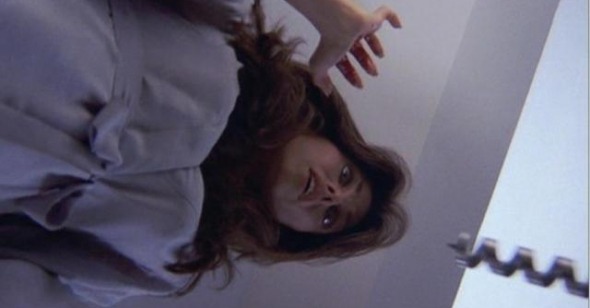View to a Kill
Vicente Rodriguez-Ortega on Body Double
The story goes that De Palma got extraordinarily sick of his buddies Spielberg and Lucas making the big bucks and tired of Coppola and Scorsese being exalted to the Olympus of cinematic auteurism, and that his response was a big “fuck you” to Hollywood in the shape of Body Double (1984). The film was budgeted slightly over $10 million, and its total gross in the U.S. market barely passed the $8 million mark. Not accidentally, the film he delivered a year before, the now-cult classic and gangsta rap wet dream Scarface, scarcely surpassed $4.5 million at the time of its release, despite a $25 million budget. Along with Wise Guys, Body Double indeed marked the new master of suspense’s lowest point, in the eyes of the studios; it wasn’t until the smashing success of The Untouchables, three years later, that he would rebound into the Hollywood cosmos.
To call Body Double excessive would be a nearly irresponsible understatement. To label it a combo-remake of Vertigo and Rear Window is merely to state the obvious. The film may be better understood as a reimagining of De Palma’s own body of work, and, more specifically, as an accentuated bricolage of three of his previous efforts—Sisters, Obsession, and Dressed to Kill. These films are, in turn, twisted remakes of Vertigo, Psycho, or Frenzy, in some cases filtered through the lens of late Seventies and early to mid Eighties slasher films. However, Body Double pushes the envelopes of excess and artificiality as far as possible. It questions its adherence to genre by defying two of the fundamentals of the above-mentioned tradition, causal verisimilitude and visual transparency, offering instead a multilayered reflection on the act of filmmaking itself, as well as of looking, via one of the most inept ensembles of actors ever put together and the continuous undermining of its own narrative strands. In De Palma’s twisted hands, the film’s main themes—the double, sexual perversion, and gruesome violence—become nothing but a series of magic tricks that reveal the slasher film’s audiovisual fabric, leaving the spectator alone with the naked images and sounds of film itself.
Body Double fastidiously challenges the spectator to ask for more. One night, Jake Scully (Craig Wasson, incomparable indeed) realizes that the life of his favorite window exhibitionist, Gloria Revelle, is in danger—she has walked into her house while a gigantic man, referred to as the “Indian,” is robbing her safe. With all of this visible, Rear Window–style, to Scully, he runs over to her apartment in a futile attempt to save her life. How does the Indian dispatch Mrs. Revelle? With nothing less than a power drill. De Palma predictably chooses to cut back and forth between Scully’s race to the house and the plastic surgery-mediated beauty’s imminent demise, but furthermore, as the Indian is about to penetrate her precious belly, De Palma cuts from an extreme close-up of the tool approaching the woman’s body and the electric outlet from where it gets power. Of course, nearing the moment of impact, the drill gets unplugged. Cut to Scully, running out of air, still a few hundred yards from the house. Cut to the Indian replugging the weapon. Cut to Scully breaking into the house downstairs and being attacked by a vicious dog. Cut to the Indian as he corrals Revelle and finally penetrates her. A pool of blood seeps through the ceiling from upstairs.
If in Scarface De Palma took every possible chance to use a crane shot, regardless of its narrative appropriateness, in Body Double, he embraces the clichés of suspense mechanics to the point of spectacular senselessness, which invariably points to its utter constructedness. In no moment of the film does De Palma takes his subject seriously enough to generate actual chills and thrills; conversely, he crowns stupidity, celebrates Eighties crap music (Frankie Goes to Hollywood’s “Relax”), and glamorizes ugliness. Body Double functions as a form of reflexive self-appropriation; it doesn’t intend to engage the spectator’s bodily reactions—a staple of the slasher—but rather generate confusion and, ultimately, laughter. Consequently, Body Double’s contemporary analogy would not be the carefully calculated interplay between humor and horror in Wes Craven’s Scream, but rather the throwaway, “quote, forget, and move on” approach that characterizes the Scary Movie films. The difference between De Palma’s celebration of crap, and Dimension’s profitable franchise is that whereas the latter is content with using box-office revenue as an index to determine its quotable objects of desire, the former is a centripetally oriented package, only understandable for the connoisseurs of its director's oeuvre. Otherwise, its imbecilic acting, narrative freneticism, explicitly dirty tone, and shamelessly gimmicky twists turn into an incomprehensible puzzle the average moviegoer can simply assess: “It sucks!”
As some of the other writers have expressed in this issue of Reverse Shot, De Palma may well be one of the greatest contemporary U.S. comic auteurs. I do not feel this is, by any means, a far-fetched argument. Furthermore, his repeated enactments of the Hitchcock thriller and the slasher film became, in the last three decades, increasingly excessive spectacles of unparalleled perversity, and they may constitute both the most degenerate body of work in Hollywood history, as well as the most striking serialization of the same basic subject matters and audiovisual motifs one has ever witnessed. Thus, De Palma is a genre of his own, one that explicitly challenges the sufficiency of parody and pastiche to account for how filmmakers cross-fertilize each other. De Palma’s works are never simply anchored in parody or blank imitation. They exist somewhere in between—they are allusion, imitation, appropriation, and remake, all veering off the track, full-frontal provocations that interrogate the very core of cinema craft.
